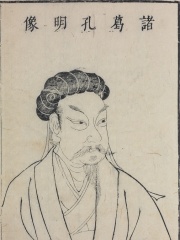
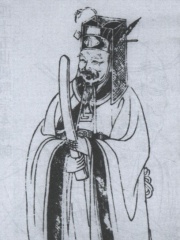
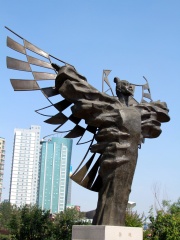
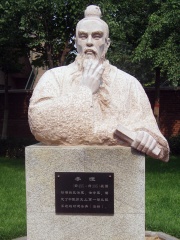
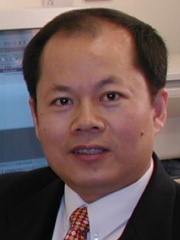
The Most Famous
ENGINEERS from China
Top 6
The following people are considered by Pantheon to be the most legendary Chinese Engineers of all time. This list of famous Chinese Engineers is sorted by HPI (Historical Popularity Index), a metric that aggregates information on a biography's online popularity.

1. Zhuge Liang (181 - 234)
With an HPI of 79.02, Zhuge Liang is the most famous Chinese Engineer. His biography has been translated into 46 different languages on wikipedia.
Zhuge Liang () (181 AD – September or October 234 AD), also commonly known by his courtesy name Kongming, was a Chinese statesman, strategist and inventor who lived through the end of the Eastern Han dynasty (c. 184–220) and the early Three Kingdoms period (220–280). During the Three Kingdoms period he served as Imperial Chancellor (or Prime Minister) of the state of Shu Han (221–263) from its founding in 221 and later as regent from 223 until his death. Zhuge is recognised as the most accomplished strategist of his era. His reputation as an intelligent and cultured scholar grew even while he was living in relative seclusion, earning him the nickname "Wolong" or "Fulong" (both meaning "Sleeping Dragon"). Zhuge Liang's methods of administration drew both from Legalism as well as Confucianism. He was critical of the Legalist thought of Shang Yang, and advocated benevolence and education as tenets of being a ruler. He compared himself with Guan Zhong, developing Shu Han's agriculture and industry to become a regional power. He attached great importance to the works of Shen Buhai and Han Fei, refusing to indulge local elites and adopting strict, but fair and clear laws. In remembrance of his governance, local people maintained shrines to him for ages. Zhuge is an uncommon two-character Chinese compound family name. In 760, when Emperor Suzong of the Tang dynasty built a temple to honour Jiang Ziya, he had sculptures of ten famous historical military generals and strategists placed in the temple flanking Jiang Ziya's statue: Zhuge Liang, Bai Qi, Han Xin, Li Jing, Li Shiji, Zhang Liang, Sima Rangju, Sun Tzu, Wu Qi and Yue Yi.

2. Su Song (1020 - 1101)
With an HPI of 66.74, Su Song is the 2nd most famous Chinese Engineer. His biography has been translated into 35 different languages.
Su Song (Chinese: 蘇頌; Pe̍h-ōe-jī: So͘ Siōng, 1020–1101), courtesy name Zirong (Chinese: 子容; Pe̍h-ōe-jī: Chú-iông), was a Chinese polymathic scientist and statesman who lived during the Song dynasty (960–1279). He excelled in numerous fields including but not limited to mathematics, astronomy, cartography, geography, metallurgy, mechanical engineering, hydraulic engineering, poetry, and statesmanship. Su Song was the engineer for a hydro-mechanical astronomical clock tower located in Kaifeng. It employed an early escapement mechanism. The escapement mechanism of Su's clock tower was invented by the Tang dynasty Buddhist monk Yi Xing and government official Liang Lingzan in 725 AD to operate a water-powered armillary sphere, however Su's armillary sphere was the first to utilize a mechanical clock drive. Su's clock tower also featured the oldest known endless power-transmitting chain drive, called the tian ti (天梯), or "celestial ladder", as depicted in his horological treatise. The clock tower had 133 different clock jacks to indicate and sound the hours. The clock was dismantled by the invading Jurchen army in 1127 AD, and although attempts were made to reassemble it, the tower was never successfully reinstated. Su Song's treatise about the clock tower, Xinyi Xiangfayao (新儀象法要), was written in 1092 and received its official printed publication in 1094. The Xinyi Xiangfayao was Su's best-known treatise, but the polymath compiled other works as well. He completed a large celestial atlas of several star maps, several terrestrial maps, as well as a treatise on pharmacology. The latter discussed related subjects on mineralogy, zoology, botany, and metallurgy.

3. Lu Ban (507 BC - 440 BC)
With an HPI of 63.28, Lu Ban is the 3rd most famous Chinese Engineer. His biography has been translated into 21 different languages.
Lu Ban (c. 507–444 BC) was an ancient Chinese master carpenter, architect, structural engineer and inventor during the Spring and Autumn period of the Eastern Zhou Dynasty. He is revered as the Chinese Deity (Patron) of builders and contractors.

4. Li Kui (500 BC - 400 BC)
With an HPI of 61.86, Li Kui is the 4th most famous Chinese Engineer. His biography has been translated into 19 different languages.
Li Kui (Chinese: 李悝; pinyin: Lǐ Kuī; Wade–Giles: Li K'uei; 455–395 BC) was a Chinese hydraulic engineer, philosopher, and politician. He served as minister and court advisor to Marquess Wen of Wei (r. 403–387 BC). In 407 BC, he wrote the Canon of Laws. Said to have been a main influence on Shang Yang, it served the basis for the codified laws of the Qin and Han dynasties. His political agendas, as well as the Book of Law, had a deep influence on later thinkers such as and Shang Yang and Han Fei, who would later develop the philosophy of Legalism based on Li Kui's reforms.
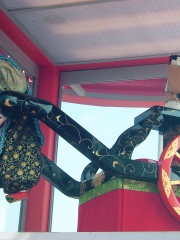
5. Ma Jun (200 - 265)
With an HPI of 60.24, Ma Jun is the 5th most famous Chinese Engineer. His biography has been translated into 15 different languages.
Ma Jun (fl. 200–265), courtesy name Deheng, was a Chinese practical man, inventor, and politician who lived in the state of Cao Wei during the Three Kingdoms period of China. His most notable invention was that of the south-pointing chariot, a directional compass vehicle which actually had no magnetic function, but was operated by use of differential gears (which applies equal amount of torque to driving wheels rotating at different speeds). It is because of this revolutionary device (and other achievements) that Ma Jun is known as one of the most brilliant mechanical engineers and inventors of his day (alongside Zhang Heng of the earlier Eastern Han dynasty). The device was re-invented by many after Ma Jun, including the astronomer and mathematician Zu Chongzhi (429–500). In the later medieval dynastic periods, Ma Jun's south-pointing chariot was combined in a single device with the distance-measuring odometer.

6. Da-Wen Sun (b. 1960)
With an HPI of 53.22, Da-Wen Sun is the 6th most famous Chinese Engineer. His biography has been translated into 25 different languages.
Sun Dawen (simplified Chinese: 孙大文; traditional Chinese: 孫大文; pinyin: Sūn Dàwén; Jyutping: Syun1 Daai6 Man6; ), known as Da-Wen Sun, is a Chinese-born professor who studies food engineering at University College Dublin. Professor Sun is an Academician of six academies including Royal Irish Academy, Academia Europaea (The Academy of Europe), Polish Academy of Sciences, International Academy of Food Science and Technology, International Academy of Agricultural and Biosystems Engineering and International Academy of Refrigeration. He is also President of International Commission of Agricultural and Biosystems Engineering (CIGR).
People
Pantheon has 6 people classified as Chinese engineers born between 507 BC and 1960. Of these 6, 1 (16.67%) of them are still alive today. The most famous living Chinese engineers include Da-Wen Sun. The most famous deceased Chinese engineers include Zhuge Liang, Su Song, and Lu Ban.
Living Chinese Engineers
Go to all RankingsDeceased Chinese Engineers
Go to all RankingsZhuge Liang
181 - 234
HPI: 79.02
Su Song
1020 - 1101
HPI: 66.74
Lu Ban
507 BC - 440 BC
HPI: 63.28
Li Kui
500 BC - 400 BC
HPI: 61.86
Ma Jun
200 - 265
HPI: 60.24

